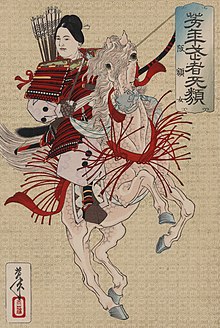Hangaku Gozen: Difference between revisions
→Culture references: replace what-when-how by actual source that they're copying from |
Cyberbot II (talk | contribs) Rescuing 1 sources, flagging 0 as dead, and archiving 0 sources. #IABot |
||
| Line 13: | Line 13: | ||
== Culture references== |
== Culture references== |
||
Hangaku appears in the ''[[Azuma Kagami]]''.<ref>[http://www.nijl.ac.jp/databases/db-room/genpon/azutext2.htm] {{ |
Hangaku appears in the ''[[Azuma Kagami]]''.<ref>[http://www.nijl.ac.jp/databases/db-room/genpon/azutext2.htm] {{wayback|url=http://www.nijl.ac.jp/databases/db-room/genpon/azutext2.htm |date=20050912042530 }}</ref> |
||
Hangaku is said to have been "fearless as a man and beautiful as a flower,"<ref>{{cite book |last=Beard |first=Mary |year=1953 |title=The Force of Women in Japanese History |publisher=Public Affairs Press |pages=72–73}} Cited by {{cite encyclopedia |title=Japan, Women Warriors in Ancient and Medieval Japan |first=Bernard |last=Cook |year=2006 |publisher=[[ABC-CLIO]] |encyclopedia=Women and War: A Historical Encyclopedia from Antiquity to the Present |pages=326–327 |url=https://books.google.com/books?id=lyZYS_GxglIC&pg=PA326}}</ref> and to have wielded a [[naginata]] in battle. Many storytellers and printmakers have portrayed her in their works, including [[Utagawa Kuniyoshi|Kuniyoshi]], who produced a series of warrior women prints. This series also included such historical or literary figures as [[Tomoe Gozen]], [[Shizuka Gozen]], and [[Hōjō Masako]]. |
Hangaku is said to have been "fearless as a man and beautiful as a flower,"<ref>{{cite book |last=Beard |first=Mary |year=1953 |title=The Force of Women in Japanese History |publisher=Public Affairs Press |pages=72–73}} Cited by {{cite encyclopedia |title=Japan, Women Warriors in Ancient and Medieval Japan |first=Bernard |last=Cook |year=2006 |publisher=[[ABC-CLIO]] |encyclopedia=Women and War: A Historical Encyclopedia from Antiquity to the Present |pages=326–327 |url=https://books.google.com/books?id=lyZYS_GxglIC&pg=PA326}}</ref> and to have wielded a [[naginata]] in battle. Many storytellers and printmakers have portrayed her in their works, including [[Utagawa Kuniyoshi|Kuniyoshi]], who produced a series of warrior women prints. This series also included such historical or literary figures as [[Tomoe Gozen]], [[Shizuka Gozen]], and [[Hōjō Masako]]. |
||
Revision as of 04:39, 14 February 2016
This article needs additional citations for verification. (September 2011) |

Lady Hangaku (坂額御前, Hangaku Gozen) was a female warrior samurai, one of the relatively few Japanese warrior women commonly known in history or classical literature.
Early life
She lived during the end of the Heian and the beginning of the Kamakura periods. Her other names include Itagaki (板額、飯角). She was the daughter of a warrior named Jō Sukekuni (城資国), and her siblings were Sukenaga and Sukemoto (or Nagamochi).
Career and capture
The Jō were warriors, allies of the Taira clan, in Echigo Province (present-day Niigata Prefecture). They were defeated in the Genpei Wars, and lost most of their power. In 1201, together with her nephew Jō Sukemori, she raised an army in response to Sukemoto's attempt (the Kennin Uprising) to overthrow the Kamakura Shogunate. Hangaku and Sukenaga took a defensive position at a fort at Torisakayama under attack from Sasaki Moritsuna. Hangaku commanded 3,000 soldiers to defend against an army of 10,000 soldiers loyal to the Hōjō clan.
Ultimately she was wounded by an arrow and captured; the defenses then collapsed. Hangaku was taken to Kamakura. When she was presented to the shogun Minamoto no Yoriie, she met Asari Yoshitō, a warrior of the Kai Genji, who received the shogun's permission to marry her. They lived in Kai, where she is said to have had one daughter.
Culture references
Hangaku appears in the Azuma Kagami.[1]
Hangaku is said to have been "fearless as a man and beautiful as a flower,"[2] and to have wielded a naginata in battle. Many storytellers and printmakers have portrayed her in their works, including Kuniyoshi, who produced a series of warrior women prints. This series also included such historical or literary figures as Tomoe Gozen, Shizuka Gozen, and Hōjō Masako.
References
- ^ [1] Template:Wayback
- ^ Beard, Mary (1953). The Force of Women in Japanese History. Public Affairs Press. pp. 72–73. Cited by Cook, Bernard (2006). "Japan, Women Warriors in Ancient and Medieval Japan". Women and War: A Historical Encyclopedia from Antiquity to the Present. ABC-CLIO. pp. 326–327.
